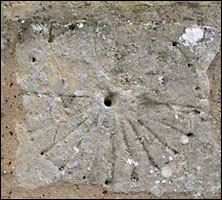![]()
The contents on this page remain on our website for informational purposes only.
Content on this page will not be reviewed or updated.
 |
|
 |
|
|
||||
|
Timely Memorials
|
||||
|
||||
|
As no doubt has everyone from time to time, the other day I was contemplating the intricacies of the anchor escapement of mechanical clocks, and so whilst at the city centre took the opportunity to closely observe the workings of that magnificent example not far from Middleton Hall. And so being lost in wonder, it was not for awhile that I became aware of the incredulous looks from a woman shopper, although to be honest nowadays any looks from any female are likely to be incredulous, but nevertheless greatly treasured. However, in the case of this lady her first impression was obviously ‘anorak,’ and she quickly hurried off. Oh well, I suppose oscillating coil springs aren’t everyone’s idea of a romantic introduction. Which leads to the subject of the ecclesiastical timepieces of Milton Keynes, or at least some of them. When attending church services, in early times in sunny conditions ‘scratch dials’ provided a primitive means by which parishioners could tell the time, for by inserting a finger in the central hole the hour could be approximately read by noting where the shadow fell. Bordering the doorway, two examples may to be seen at Tattenhoe church, whilst, as evidence for rebuilding work, a stone block on which a scratch dial was inscribed is now to be seen in Wicken church, bordering the doorway to the stairs of the tower chamber. At Stewkley, as an indication that the early church was constructed without a porch, a scratch dial may be seen bordering the south doorway, whilst also at Stewkley in the churchyard, near to the west door, may be seen a later timekeeping progression in the form of a sun dial. Whilst the stone pedestal was given in 1912 (as a replacement for a decayed wooden post) the actual dial dates from 1771, and in the churchwardens’ accounts for July 24th, 1771 may be seen the relevant entry; ‘Paid for a Dial plate £1 11 0.’ With the invention of mechanical clocks, it would often be village blacksmiths who had the necessary metal working skills, and locally the Chandler family of Drayton Parslow would - apart from bell founding - become noted for clock making. Indeed, in Whaddon church a brass plate inscribed ‘Anthony Chandler made me’ is to be found on an early weight driven clock mounted upon an oaken frame. As for Newton Longville, in the parish church may be seen a similar clock, with there being good reason to believe that this was made by Richard Chandler, since in the churchwardens’ accounts is stated that he was paid £5 in 1689 for ‘working the clock.’ Clocks have often been provided as memorials, and at Emberton in the centre of the village stands a clock tower as a ‘lasting memory’ to Margaret, the wife of a past parish rector. He had the feature constructed in 1846, and a clock and also a bell - inscribed ‘John Rudhall Gloucester, 1806’ - were then presented by Miss Hughes of the village. As for Chicheley, in the presence of Earl Mountbatten, on June 3rd, 1973 the church clock was dedicated to the memory of the 2nd Earl Beatty, who lies buried in the churchyard. He was the son of the World War One naval hero David Beatty, who lead the advance British naval forces at the Battle of Jutland, and in fact the actual desk used by him aboard his flagship, the Lion, came to be displayed in Chicheley Hall, along with many other exhibits of his naval career. But, as always, that’s another story.
|
||||
|
|
||||
|
|
||||


